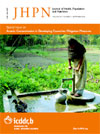
|
The Journal of Health, Population and Nutrition
icddr,b
ISSN: 1606-0997
EISSN: 1606-0997
Vol. 32, No. 1, 2014, pp. 118-129
|
 Bioline Code: hn14015
Bioline Code: hn14015
Full paper language: English
Document type: Research Article
Document available free of charge
|
|
|
The Journal of Health, Population and Nutrition, Vol. 32, No. 1, 2014, pp. 118-129
| en |
Training Traditional Birth Attendants on the Use of Misoprostol and a Blood Measurement Tool to Prevent Postpartum Haemorrhage: Lessons Learnt from Bangladesh
Bell, Suzanne; Passano, Paige; Bohl, Daniel D.; Islam, Arshadul & Prata, Ndola
Abstract
A consensus emerged in the late 1990s among leaders in global maternal health that traditional birth attendants
(TBAs) should no longer be trained in delivery skills and should instead be trained as promoters
of facility-based care. Many TBAs continue to be trained in places where home deliveries are the norm and
the potential impacts of this training are important to understand. The primary objective of this study was
to gain a more nuanced understanding of the full impact of training TBAs to use misoprostol and a blood
measurement tool (mat) for the prevention of postpartum haemorrhage (PPH) at home deliveries through
the perspective of those involved in the project. This qualitative study, conducted between July 2009 and
July 2010 in Bangladesh, was nested within larger operations research, testing the feasibility and acceptability
of scaling up community-based provision of misoprostol and a blood measurement tool for prevention
of PPH. A total of 87 in-depth interviews (IDIs) were conducted with TBAs, community health workers
(CHWs), managers, and government-employed family welfare visitors (FWVs) at three time points during
the study. Computer-assisted thematic data analysis was conducted using ATLAS.ti (version 5.2). Four primary
themes emerged during the data analysis, which all highlight changes that occurred following the
training. The first theme describes the perceived direct changes linked to the two new interventions. The
following three themes describe the indirect changes that interviewees perceived: strengthened linkages between
TBAs and the formal healthcare system; strengthened linkages between TBAs and the communities
they serve; and improved quality of services/service utilization. The data indicate that training TBAs and
CHW supervisors resulted in perceived broader and more nuanced changes than simply improvements in
TBAs’ knowledge, attitudes, and practices. Acknowledgeing TBAs’ important role in the community and
in home deliveries and integrating them into the formal healthcare system has the potential to result in
changes similar to those seen in this study.
Keywords
Blood measurement tool; Misoprostol; Postpartum haemorrhage; Qualitative; Traditional birth attendant; Training; Bangladesh
|
| |
© The Journal of Health, Population and Nutrition
Alternative site location: http://www.jhpn.net
|
|
